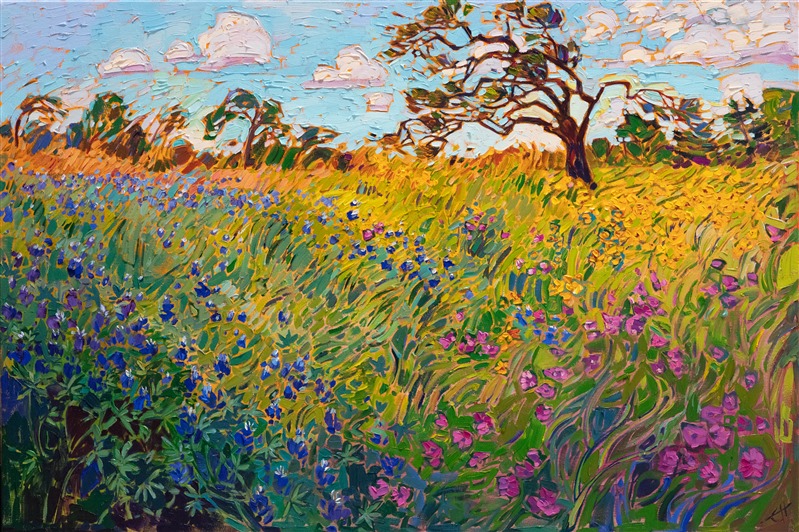Top-Tier High-End Oil Paintings for Sale Now
Top-Tier High-End Oil Paintings for Sale Now
Blog Article
The Advantages of Acquiring Oil Paints: Why They Are a Timeless Financial investment
The advantages of acquiring oil paintings extend beyond plain looks. These art work bring historic significance and cultural worth, making them worthwhile enhancements to any collection. Their distinct textures and strategies add to an interesting visual experience. Established musicians often see their job appreciate over time, providing a possible financial advantage. As one checks out the multifaceted factors for purchasing oil paintings, the much deeper implications of such a choice become increasingly noticeable
The Visual Allure of Oil Paints
The allure of oil paintings exists in their lively shades and rich structures, which can change any area into an interesting environment. These art work possess a depth that captivates viewers, drawing them into the ins and outs of the brushstrokes and the interaction of light and darkness. The glossy finish of oil paint boosts the visual experience, enlivening scenes and topics in a manner that various other mediums frequently can not attain. Additionally, the variety of styles-- from classic to modern-- enables a varied choice that can complement any décor. The emotional resonance shared with color choices and methods includes a layer of link between the observer and the art work, making oil paintings not just decorative products, however effective expressions of artistic vision.
Historical Value and Cultural Value
Oil paints function as vital links to an artistic heritage, showcasing methods and styles that have progressed over centuries. They encapsulate social expressions and identities, mirroring the worths and stories of their time. By getting these jobs, people add to the preservation of history and the appreciation of diverse social heritages.
Imaginative Heritage Conservation
While lots of may ignore the importance of creative heritage, buying oil paintings plays a vital function in protecting historic and cultural stories. These art work function as aesthetic paperwork of their time, catching the essence of societal values, practices, and historical occasions. By acquiring oil paintings, enthusiasts add to the protecting of cultural heritages, guaranteeing that future generations can appreciate and learn from these artistic expressions. Each item reflects the unique story of its maker and the context in which it was made. Additionally, the continued gratitude and display of oil paints in different settings help to promote an understanding of diverse artistic movements, improving the social landscape. Spending in oil paints is not simply an economic decision but an act of cultural stewardship.
Social Expression and Identification
Art acts as an effective medium for social expression and identification, reflecting the diverse stories that form cultures. Oil paintings, particularly, catch the essence of social heritage, highlighting historical contexts and sociopolitical environments. Each brushstroke shares feelings and tales unique to particular customs, permitting viewers to engage with the artist's cultural history. This link fosters a feeling of belonging and understanding amongst different areas. Furthermore, oil paintings typically function as visual paperwork of cultural development, showcasing changes in identity over time. The financial investment in these art work not just supports artists however also preserves cultural heritages, making them substantial possessions for collection agencies. Inevitably, oil paints enhance one's appreciation for the ins and outs of human experience and the rich tapestry of social identification.
Recognition in Value Gradually

The admiration of oil paints over time is influenced by numerous variables, including historic value patterns that reflect transforming tastes and social importance. Additionally, the reputation of the musician plays an essential role in determining the art work's market price, usually boosting as the musician gains recognition. Market demand changes can further influence costs, making oil paintings a possibly lucrative investment for collection agencies.
Historic Value Patterns
As collection agencies look for to buy substantial possessions, the historical value patterns of oil paints expose an engaging story of appreciation in time. Historically, oil paints have actually shown a constant higher trajectory in value, especially for works by well-known musicians. Economic cycles and market need have influenced these trends, with durations of boosted rate of interest typically causing significant price rises. Auction documents regularly highlight the impressive returns accomplished by famous items, additionally strengthening the idea of oil paints as practical long-term investments. Furthermore, cultural motions and shifts in collection agency choices have actually occasionally spurred unforeseen gratitude, revealing that the art market, while rather unpredictable, typically prefers top quality oil paintings. Understanding these historical trends can assist financiers in making notified choices.
Musician Reputation Impact
While the track record of an artist plays a crucial function in the appreciation of oil paints, it is essential to acknowledge that this impact can differ substantially based on numerous factors. Established musicians, particularly those with a considerable historical or social influence, often tend to see their works value a lot more swiftly. Alternatively, lesser-known or arising artists may not experience the very same degree of need, affecting their art work's worth. Additionally, the artist's ability to create a regular body of job and maintain importance in the art world can influence lasting gratitude. Collectors usually look for works from musicians that are recognized by reputable galleries and organizations, which can additionally boost the value of an oil painting in time, making artist online reputation a vital consideration in investment choices.

Market Demand Fluctuations
Just how do market demand fluctuations affect the recognition of oil paintings over time? The worth of oil paintings is fundamentally linked to market need, which can differ based on economic problems, fads, and collection agencies' preferences. In times of financial success, demand frequently increases, bring about increased rates as more buyers enter the marketplace. Conversely, throughout economic slumps, need might diminish, creating values to stagnate and even decrease. In addition, the appeal of certain artists can move, influencing their work's worth. Ultimately, understanding market need is essential for capitalists, as well-managed collections can value substantially in time, mirroring both the ability of the musician and the broader market dynamics. This interplay highlights the importance of critical buying in oil painting financial investments.
One-of-a-kind Structures and Techniques
Oil paintings astound audiences with their distinct textures and techniques, showcasing the artist's proficiency over the tool. The thick application of paint, called impasto, produces a three-dimensional impact, welcoming touch and boosting aesthetic deepness. Artists typically employ numerous brush strokes, layering, and polishing methods to attain intricate details and luminescent colors. This flexibility enables abundant contrasts and refined shifts, making each artwork distinctively meaningful. In addition, the slow-moving drying time of oil paint enables artists to blend colors effortlessly, resulting in smooth gradients and vibrant colors. These strategies add to the paint's total character, making it an engaging prime focus. Each oil painting functions as a sign of the creative thinking and skill fundamental in standard creative techniques.
Convenience in Home Decor
The unique textures and strategies of oil paintings not just display creative ability yet additionally boost their adaptability in home design. These art work can seamlessly match various interior designs, from modern minimalist to typical style. Oil paints serve as focal factors, drawing focus and stimulating conversation among visitors. Their rich colors and deepness can harmonize with different shade schemes, making them adaptable to transforming style fads. Furthermore, the emotional vibration of oil paintings can create atmosphere, whether it be heat in a comfortable living-room or vibrancy in an innovative work space. By including oil paintings, property owners raise their spaces, transforming them right into thoughtfully curated atmospheres that mirror individual taste and creative gratitude. Ultimately, oil paints are a long-lasting option for boosting home aesthetic appeals.
Link to Distinguished Artists
While many art forms can stimulate adoration, buying oil paints commonly establishes a special connection to renowned musicians throughout history. Owning an oil painting allows enthusiasts to involve with the innovative visions of masters like Van Gogh, Monet, and Rembrandt. Each brushstroke symbolizes the musician's feelings, intents, and techniques, offering insight right into their world. This connection transcends time, as each item lugs a story that mirrors the cultural and historic context of its creation. Collectors not just get an artwork however also a piece of the musician's legacy. As art enthusiasts discover the stories behind these paints, they obtain a much deeper gratitude for the craftsmanship and creative movements that shaped their growth, boosting the worth of their investment.
Psychological and Emotional Benefits of Art
Art often functions as a powerful catalyst for psychological and mental wellness. The existence of oil paintings in a home can evoke a variety of feelings, from harmony to motivation. Their detailed details and lively colors offer visitors a getaway, enabling representation and contemplation. Research studies recommend that involving with art can minimize stress and stress and anxiety, fostering a feeling of calm. Additionally, owning initial artwork can produce a personal link, enhancing sensations of pride and happiness. This emotional bond commonly causes a deeper admiration of one's surroundings, transforming a residence into a home. Ultimately, the emotional benefits of art extend past visual appeals, adding to general psychological wellness and enhancing life experiences.

Frequently Asked Inquiries
Just how Do I Choose the Right Oil Painting for My Space?
Selecting the right oil painting involves considering the area's color design, size, and general visual. One need to review individual taste, the paint's psychological influence, and exactly how well it matches existing style before choosing.

What Factors Influence the Worth of an Oil Painting?
The worth of more info an oil paint is affected by variables such as the musician's reputation, provenance, historical importance, problem, rarity, and market demand. Each component contributes to overall worth and desirability among collection agencies.
Exactly How Can I Care for and Keep My Oil Painting?
To look after and keep an oil paint, one should routinely dust it with a soft fabric, avoid straight sunlight exposure, control humidity levels, and take into consideration expert cleansing to protect its vibrancy and stability.
Exist Details Artists Recognized for Their Oil Paintings?
Numerous musicians are renowned for their oil paints - oil paintings for sale. Notable numbers consist of Vincent van Gogh, Claude Monet, and Rembrandt, each commemorated for their one-of-a-kind methods and payments to the art world through vibrant, distinctive oil mediums
Where Can I Acquisition Genuine Oil Paints?
Genuine oil paintings can be bought from trustworthy galleries, art fairs, and on the internet systems specializing in art. Collection agencies must confirm the authenticity and provenance prior to buying to assure an important investment. Historically, oil paints have shown a consistent upward trajectory in worth, specifically for jobs by well-known musicians. While the reputation of a musician plays a vital function in the recognition of oil paintings, it is important to identify that this impact can vary significantly based on several aspects. Oil paints captivate audiences with their unique textures and techniques, showcasing the musician's mastery over the medium. While several art kinds can evoke affection, purchasing oil paintings commonly establishes a distinct connection to renowned artists throughout history. The value of an oil paint is influenced by factors such as the musician's credibility, provenance, historical relevance, market, problem, and rarity demand.
Report this page